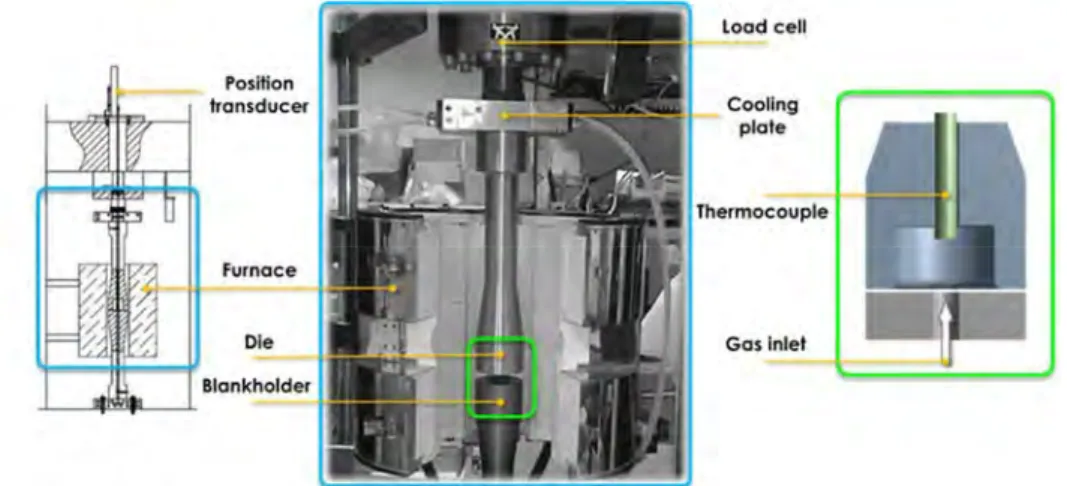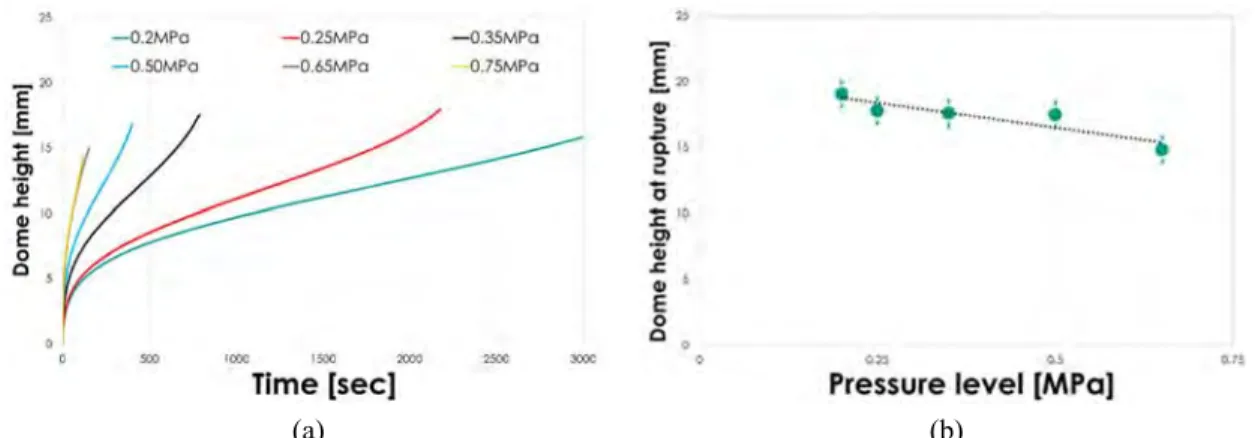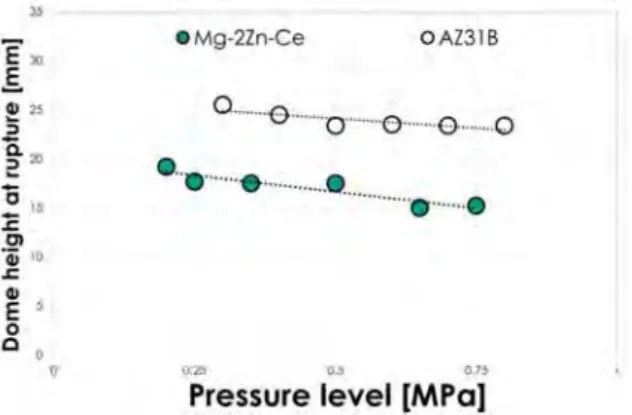Deformation behaviour of a new Magnesium ternary alloy
P. Guglielmi
1,4, b), A. Arslan Kaya
2, c), D. Sorgente
3,4, d), G. Palumbo
1,4, a)1DMMM - Politecnico di Bari, Viale Japigia 182, Bari 70126, Italy 2Engineering Faculty, Mugla Sıtkı Kocman University, Mugla, Turkey 3School of Engineering, Università degli Studi della Basilicata, Potenza, Italy
4IFN UOS Bari, Italy
a) Corresponding author: gianfranco.palumbo@poliba.it b) pasquale.guglielmi@poliba.it
c) aliarslankaya63@gmail.com d) donato.sorgente@unibas.it
Abstract. Magnesium based alloys are yet to fill a greater niche especially in the automotive and aeronautical industry.
In fact, such alloys have a big weight saving potential, together with good damping characteristics. However, nowadays about 90% of Magnesium products are produced by casting, mainly using two alloy systems, namely Mg-Al-Zn (AZ91D) and Mg-Al (AM50, AM60). Now the emphasis, especially after having achieved considerable success in creep resistance and understanding of the deformation behaviour of Magnesium, has been shifted towards wrought alloys; AZ31, in this case, is the most popular. In this work a multi-element Magnesium alloy, developed to improve the deformation capacity of such a lightweight material, has been investigated and compared to a commercial AZ31B. The possibility of adopting such a multi-element Magnesium alloy for manufacturing components via unconventional sheet forming (such as superplastic forming, warm hydroforming, incremental forming) has been proved in the present work focusing the attention on the superplastic field. Free inflation tests were thus conducted at 450°C setting constant pressure to investigate the superplastic behaviour (in terms of dome height and strain rate sensitivity index) of both the multi-element Magnesium alloy (Mg-2Zn-Ce) and the commercial one (AZ31B). To enhance information on the thickness distribution and investigate the microstructure evolution, metallographic analyses on the samples used to carry out free inflation tests were also performed. The developed ternary alloy manifested quite a good deformation behaviour (high strain rate sensitivity index), even being tested in the as cast condition; in addition a limited grain coarsening was observed in the specimens after deformation.
INTRODUCTION
The sharp reduction of fuel consumption and pollutant emissions required by the transport field has been favouring a marked increase in the use of the so-called “light alloys” [1]. In this scenario, Aluminium (Al) and Magnesium (Mg) alloys are good candidates. Furthermore, the geometry of components is becoming more and more complex thus requiring very high material deformation capacity. This aspect, in the case of Al and Mg alloys, requires to increase the working temperature in order to improve formability [2, 3] and to reduce the springback phenomenon [4]. In addition, it is known that the deformation behaviour of a material is strongly influenced by its chemical composition and by the type of imposed deformation. In fact, the correct selection of the alloying elements are fundamental to achieve a high performance alloy. The principal alloying elements to improve the mechanical performance end/or the deformation behaviour of the Mg alloys are Yttrium, Zinc (impart strengthening) and Cerium (increases deformation capacity while also providing strength) [5, 6]. Yttrium and Zinc addition has been reported to increase the ductility even at room temperature via activating additional slip planes, increasing the strength and reducing texture [6, 7]. Finally, if compared to pure Mg, Ce addition promotes more homogeneous deformation [8]. On the basis of these considerations, in this work, the attention was focused on a ternary Mg-2Zn-Ce alloy experimentally obtained and tested by means of free inflation tests at 450 °C. Subsequently, the results coming from the experimental tests were
compared with the results available in literature regarding the Mg alloy AZ31B [9] In addition to the metallographic investigation, results carried out by means of free inflation tests have been also presented in terms of dome height and thickness reduction. Finally, to evaluate the alloy superplastic behaviour, the attention was focused on the strain rate sensitive index (m-value). This index is a very important parameter to evaluate the deformation behaviour; in particular, it is directly related to the ability to increase formability with temperature. In addition to the temperature, m is also strongly influenced by particle size. High m-values imply a high resistance to local necking with marked elongation. Commonly, for most materials m-value is less than 0.1; on the contrary, when superplastic conditions are reached, it could vary between 0.3 and 0.9.
MATERIAL, EXPERIMENTAL SETUP AND PROCEDURE
Material
An electrical furnace with protective argon atmosphere was used to produce the Mg-2Zn-Ce alloy. The nominal composition of the alloy was obtained by means of the Energy-Dispersive X-ray Spectroscopy (EDS) method and reported in Table 1.
TABLE 1. Mg-2Zn-Ce nominal composition [Weight %]
Ce Zn Mg
2.02 1.90 Balance
SEM micrograph of the as-cast structures is shown in Fig. 1. It is possible to note that the second phases constitute relatively more continuous network along the grain boundaries.
FIGURE 1. SEM micrographs of the as-cast structures
Experimental setup and procedure
The material characterization by means of free inflation tests was performed using a 200 kN universal INSTRON testing machine on which the equipment shown in Fig. 2 was assembled.
In particular, by means of a pressurized (argon) gas, an 80 mm diameter circular sample (1 mm thick) was clamped between the blankholder and the die having a cylindrical cavity. The constant temperature of 450 °C during the test was guaranteed by the electric furnace. To monitor both the temperature and the sample height during the test, a K-type thermocouple connected to a magnetostrictive linear position sensor was used.
All tests were performed according to two strategies: setting a Constant Pressure (CP tests) or varying the pressure between two values (Jump pressure tests, JP tests). To determine the alloy performance, the m-value, the thickness distribution along the sample cross section and the height at rupture were considered. Finally, to perform metallographic analyses, the obtained samples were prepared (cut, mounted, polished and chemically etched) and observed using an optical microscope.
/' ·1\',
£
~:
i<\J
. . ' ..._-✓-<
' -~
\>--
'J· \ .
'1i
~...
\_....-,"'.
.
, ·r. . _,,· ,. - .FIGURE 2. Free inflation tests experimental layout
Starting from the results available in literature for a commercial AZ31B alloy [9], in the present work, in order to experimentally characterize the Mg-2Zn-Ce alloy, the attention was focused on a temperature of 450 °C, very close to the optimal temperature (i.e. the temperature at which the m-value is maximum) for the AZ31B. Five different gas pressure levels (0.20, 0.25, 0.35, 0.50 and 0.65 MPa) were set to perform CP tests; on the contrary, JP tests were performed alternating the pressure (every 100 s) between the following levels: 0.20 – 0.25 MPa.
RESULTS AND DISCUSSION
Each test condition adopted to perform both CP and JP tests on the developed ternary alloy was replicated two times. Two formulations resulting from two different approaches were adopted to determine the m-value. The first equation (1), based on the data from CP tests, was proposed by Enikeev & Kruglov [10]:
1 2 2 1/
ln
/
ln
t
t
p
p
m
(1) Where t1 and t2 represent the forming times at constant pressures respectively p1 and p2.The approach proposed by Sorgente et al. [11], based on the data from JP tests are summarized in the following equations (2):
. 1 . 2 1 2/
ln
/
ln
h
h
p
p
m
(2)Where the subscript refers to one of two pressure levels adopted (“1” for the first gas pressure level and “2” for the second one); h and h represent the derivative with respect to time of dome height at a fixed level of pressure. It is known that m-value can be change with the deformation condition (in particular referred to the strain rate). In fact, even in the case of a constant strain rate, the m-value can vary during the forming process. For this reason, differently from the CP tests, the second approach (JP tests) takes into account a range of strain rate. In order to better investigate the alloy behaviour, very interesting could be the comparison between the two different methodologies.
The curves obtained from CP tests have been resumed in Fig. 3a; in addition, Fig. 3b depicts the maximum dome height value (i.e. when rupture occurs) as a function of the gas pressure.
PoslHon lronsducer Furnace Die load cell Cooling plole Thermocouple Gos Inlet
(a) (b)
FIGURE 3. Dome height vs time curves (a) and dome height at rupture respect to the pressure level (b) for CP tests
It can be noted that dome height increases when decreasing the pressure. For example, by decreasing the pressure from 0.75 to 0.20 MPa, the dome height at failure increases up to 30 %.
To investigate the effect of the gas pressure in terms of thinning, a comparison between the different thickness profiles (from the centre to the flanged area) has been reported in Fig. 4.
FIGURE 4. Thickness distributions for samples tested with CP methods
It is worthy of notice that the minimum thickness value was located at the dome apex for all test conditions. In particular, as evident from Fig. 3a, being the dome height at the apex closely related to the adopted gas pressure, the thickness measurements were carried out on specimens with different heights. In addition, in correspondence of the low gas pressures, a greater uniformity of thickness in the central area was recorded.
(a) (b)
FIGURE 5. Dome height vs time for the JP tests
,.
-0.2MPo -0.SOMPo-
E"'
i
QI"
,o~
E 0 C s 0 0""
0 0 «JOO 2> - 0,25MPo -0.35MPae
- 0.65MPo 0.75MPa£
»
~
-....
,
... __
~
...
!
...
.
...
,
QI 2 Q." 2 0 ~ 10 CJ) 'i .s::'
QI E 0 C•
,
,..
2000 :00:-
•
OlO G>Time [sec] Pressure level [MPa]
1.20
e
1.00 a ~ ~ '-•.s
0.80 0_
...,_;:it"
~ o•
-
o
-
~
..,.-
•
·
QJ 0.60 A _,.-'i
_
,.
r::
o--
•
t
.
•
,:::t. 0.40-~
~....
0.20 0.00 • 0.20MPo • O.SOMPo • 0.25MPo • 0.65MPo • 0.35MPo • 0.75MPo 0 5 10 15 20 25 30 Radial position [mm] -o-0.20-0.25_MPa_R1 CV 0.1 ::, 0.60
> 0.5E
o.• 0.3 0.2 0.1 0 -• 0.20-0.25_MPa_R2 Ill! tOXI I * ,ooo-
0 500 1000 1500 2000 2500An experimental curve obtained by means JP tests has been reported in Fig. 5a: the jump between the two pressure levels (0.20 and 0.25 MPa) justifies the serration of the dome height curve. As depicted in Fig. 5b, by performing JP tests, it is possible to observe the evolution of the m-value according to time.
Using the experimental curves reported in Fig. 3 and Fig. 5, it was possible to determine the m-value with the two different approaches. No statistically significant difference were found between the results obtained by the two approaches: 0.414 ± 0.06 using data from CP tests and 0.448 ± 0.02 using data from JP test.
FIGURE 6. Dome height at rupture respect to the pressure level for the two different Mg alloys
In Fig. 6, results in terms of dome height at failure from free inflation tests performed in the present work have been compared with data from previous experimental activities on the commercial alloy AZ31B Mg [9, 12]. It is possible to note that both the alloys present the same linear trend; in particular, the average dome height at rupture value of the commercial alloy is shifted upward (it is about 20 % larger). On the other hand, despite a lower capacity to deform (in terms of maximum height of the dome reached) respect the AZ31B, the experimental ternary alloy Mg-2Zn-Ce was characterized by a m-value greater than that attributable to the commercial one (about 25 percent more); in fact, the value obtained for the commercial AZ31B Mg alloy was equal to 0.312.
To evaluate the microstructural evolution, analyses by means of optical microscopy concerning Mg-2Zn-Ce samples derived from free inflation tests have been conducted. In particular, considering the best experimental deformation condition (0.20 MPa), as depicted in Fig. 7, four different sample zones were thus analysed: the flange region (a), assumed to be affected by negligible deformations, the corner (b), the half-height of the dome (c) and the dome apex (d).
FIGURE7. Micrographs corresponding to the different sample zones analysed
The general shape change and the grain boundary precipitates corresponding to the four different locations in the sample can be observed. Due to the deformation in the samples were subjected to, the grain boundaries appear to be broken into smaller parts. This aspect was emphasized in correspondence of zones very close to the dome apex. Moreover, considering the different samples zones, it is possible to observe very limited changes in the average grain
,.,
'E
,.,
.s
Ill " ~i
..
-
0 ,. :E OI Qj 1D .s= Ill E ' 0 0 0"
•Mg-2Zn-Ce OAZ31 B a., ... -0 ...,o
.. -
··
e
·
·
····
·
e
•
•
·
·-·O
.
.
.
.
...
.
.
.... ..,•
.
.
...
•
Pressure level [MPa]
size. Considering together the smaller grain size observed in the as-cast condition and high deformation capacities obtained during the forming process, it is reasonable to consider that this alloy system provides a good resistance to grain coarsening at elevated temperatures. In addition, since the m-value is higher than the conventional limit of 0.3, the alloy exhibit highly potential superplastic behaviour [13]. Furthermore, the material's ability to contain grain growth supports this assumption. In fact, despite fragmented network of precipitates along the grain boundaries during high temperature deformations has been observed, it is reasonable to assume that the presence of precipitates is capable of continue hindering the grain coarsening without leading to premature tearing or rupture.
CONCLUSIONS
In this work, the deformation behaviour of a new ternary Mg-2Zn-Ce alloy was evaluated. Starting from previously experimental evidences supported by the literature about the commercial AZ31B Mg alloy, according to which a good results in terms of dome height to rupture and m-value can be achieved at 460°C, the developed Mg-2Zn-Ce alloy was tested at 450 °C adopting two methodologies (CP and JP tests) and showing a marked deformation capacity; moreover, both CP and JP tests allowed to obtain almost similar m-values.
By decreasing the gas pressure, the dome height at rupture increased with a linear trend; for example, by decreasing the pressure from 0.75 to 0.20 MPa, a dome height at failure increase up to 30 % was obtained. By observing the samples after free inflation tests, the alloy showed a limited grain coarsening, without any rupture. The relatively fine microstructure, coupled with the m-value higher than 0.3, thus suggest the potential superplastic behaviour of such developed alloy if using appropriate process parameters (forming time and gas pressure).
As concerns the microstructure, the second phase particles located at grain boundaries seemed to fragment easily during deformation but without leading to premature tearing or rupture.
Results coming from the comparison between the two Mg alloys showed a lower value of the dome's height for the ternary alloy probably due to the manufacturing process adopted for creating the proposed alloy (foundry); for this reason, a solubilisation and precipitation heat treatment before the forming process could be useful to improve its forming behaviour.
ACKNOWLEDGEMENTS
The authors gratefully acknowledge the financial support for this work provided by TUBITAK and CNR-Italy under the Project number 213M535. We also acknowledge the support provided by the Turkish Ministry of Science, Industry and Technology under the SANTEZ project 0286.STZ.2013-2. Some of the experimental activities related to this work could be carried out thanks to the facilities of the TRASFORMA network, funded by Regione Puglia, Italy, and ILTEM of Dumlupınar University, Turkey.
REFERENCES
1. W.J. Joost, Jom. 64, 1032-1038 (2012).2. S.H. Zhang, Y.C. Xu, Z.T. Wang, Q.L. Zhang, G. Palumbo , S. Pinto , L. Tricarico, 488-489, 453-456 (2005). 3. G. Palumbo, D. Sorgente, L. Tricarico, J. of Mat. Proc. Techn. 201, 183-188 (2008).
4. V. Tabacaru, N. Oancea, J. Mater. Process. Technol. 115, 14-19 (2001).
5. S. Tekumalla, S. Seetharaman, Q.B. Nguyen, E. Wong, C.S. Goh, R. Shabadi, M. Gupta, J. Eng. Mater. Technol.
138, (2016).
6. A.A. Luo, R.K. Mishra, A.K. Sachdev, Scr. Mater. 64, 410-413 (2011).
7. S. Sandlbes, S. Zaefferer, I. Schestakow, S. Yi, R. Gonzalez-Martinez, Acta Mater. 59, 429–439 (2011). 8. J. Zhang, Y. Dou, Y. Zheng, Scr. Mater. 80, 17–20 (2014).
9. D. Sorgente, L.D. Scintilla, G. Palumbo, L. Tricarico, Int. J. Mater. Form. 3, 13–19 (2010). 10. F.U. Enikeev, A.A. Kruglov, Science 37, 473–483 (1995).
11. D. Sorgente, G. Palumbo, L. Tricarico, Key Eng. Mater. 344, 119–126 (2007).
12. S. Franchitti, G. Giuliano, G. Palumbo, D. Sorgente, L. Tricarico, Int. J. Mater. Form. 1, 1067-1070 (2008). 13. K. Manabe, H. Nishimura, Mater. Trans. 43, 2443–2448 (2002).
![TABLE 1. Mg-2Zn-Ce nominal composition [Weight %]](https://thumb-eu.123doks.com/thumbv2/9libnet/3842393.34038/2.918.318.604.538.748/table-mg-zn-ce-nominal-composition-weight.webp)


